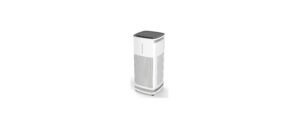Cuisinart CBK-100 Bread Maker
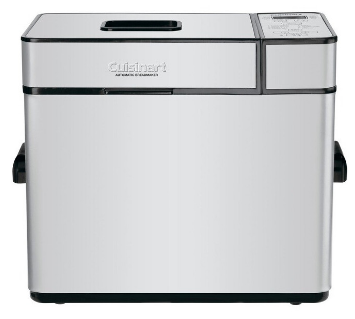
IMPORTANT SAFEGUARDS
When using electrical appliances, basic safety precautions should always be followed including the following:
- Read all instructions, product labels, and warnings before using this bread maker.
- Do not touch hot surfaces; carry the unit by handles. Always use oven mitts when handling hot material, and allow metal parts to cool before cleaning. Allow the bread maker to cool thoroughly before putting in or taking off parts.
- When the unit is not in use and before cleaning, unplug the bread maker from the wall outlet. Let the bread maker cool down thoroughly before assembling or disassembling it.
- To protect against the risk of electrical shock, do not immerse the appliance or plugs in water or other liquids.
- Close supervision is always necessary when this or any appliance is used near children or incapacitated persons.
- Do not allow anything to rest on the power cord. Do not plug in a cord where people may walk or trip on it. Unplug this bread maker from the wall outlet before you go out for a trip or long excursion.
SAVE THESE INSTRUCTIONS
FOR HOUSEHOLD USE ONLY
Notice
This appliance has a polarized plug (one blade is wider than the other). To reduce the risk of electric shock, this plug will fit in a polarized outlet only one way. If the plug does not fit fully in the outlet, reverse the plug. If it still does not fit, contact a qualified electrician. Do not modify the plug in any way
INTRODUCTION
Nothing says “home” like warm, just-baked bread. With your new automatic bread maker, all you have to do is add ingredients and select the time you’d like Cuisinart to start the process. We mix it, knead it, let it rise, and bake it. We’ve included lots of bread recipes, as well as recipes for pastries and jams. You’ll discover you’ve bought yourself much more than a breadmaker!
Parts And Features
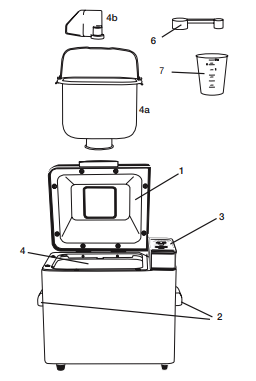
- Lid with viewing window
- Side handles
- Control Panel (see page 3 for more detail)
- Baking chamber:
- a. Removable bread pan with handle
- b. Kneading paddle
- c. Heating element (not shown)
- Power Cord (not shown)
- Measuring Spoon
- Measuring Cup
CONTROL PANEL
- LCD Display – Displays your loaf size and crust color selection along with the current function. Also used to view menu selection and delay start timer.
- Loaf Size Button – Select a 1lb, 1½ lb, or 2lb loaf.
- Crust Color Button – Select a light, medium, or dark crust.
- Menu Button – Select the program; refer to the program list for options.
- Program List – Lists the first 11 preprogrammed menu selections; use the menu button to select from this list.
MAKING BREAD
Before First Use
Before using your Cuisinart® Automatic Bread Maker for the first time, remove all protective paper and wrapping. Be sure that all parts of your new bread maker have been unpacked before discarding any packaging materials. You may want to keep the box and packaging materials for use at a later date.
Setting Up
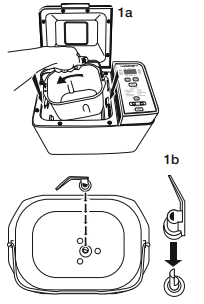
- Remove the bread pan by grasping the handle, turning the pan to the left, and pulling up. Attach kneading paddle. (see Figures 1a and 1b).
- Put ingredients in bread pan – refer to the measuring and loading ingredients section (pages 6-7) for detailed instructions.
- Insert the bread pan back into the baking chamber, turning the pan to the right. Be sure it locks in place.
- Close the lid and plug in the bread maker
Programming
- Select your loaf size (1, 1½, or 2 lbs) by pressing the Loaf Size button until your desired size is selected.
- Select your crust color (light, medium, or dark) by pressing the Crust Color button until your desired color is selected. Your current selection will be displayed on the LCD panel.
- Select your program number by pressing the Menu button until your desired program is displayed. (The pre-programmed menu selections are listed on the control panel for easy reference.)
Begin the process
- a. Start – if you would like the bread-making process to start immediately, press the Start/Stop button now.
- b. Delay Start – The delay timer allows you to delay the bread-making process up to 13 hours. The delay start cannot be used with the Rapid Bake program and is not recommended for use with dough, jam, or gluten-free settings.
Note: Do not use perishable ingredients such as milk, eggs, cheese, and yogurt with the delayed start function.
To set the Delay Start
- Add ingredients.
- Select your loaf size, crust color, and program.
- Press the + button repeatedly until the total delay time desired is displayed. If you go past the required time, press the – button to go back. The timer will move in 10-minute increments. Set your time based on when you would like your bread to be complete. If, for example, the time is 1 p.m. and you plan for a finished loaf at 10 p.m., set your delay timer for 9 hours.
- Press the Start/Stop button to begin the delay start countdown.
During Bread Making
- The Process Once you start a selected program, the unit will automatically take care of each step of the bread-making process until the loaf finishes baking. An indicator on the LCD will display the current function: Delay Start, Preheat, Knead, Rest, Rise, Bake, Keep Warm, or End.
- Preheat: Some programs require the bread maker to pre-heat. During this time, the unit is heating up. Note: this function is not required for all programs
- Knead: Three kneads are standard for most settings.
- Rest: These are periods of resting in which the unit will not be active except for the countdown display.
Options
- Mix-Ins: During the last 8 minutes of the second kneading cycle with the Basic/White, Whole Wheat, French/Italian, and Sweet programs, an audible signal 5 of short beeps will sound to remind you to add any additional ingredients your recipe requires. To do so, open the lid and add additional ingredients. Be sure to close the lid, once finished.
- After mixing/kneading is complete there will be an audible signal of 6 short beeps, before the last rise cycle, indicating the point at which the mixing/kneading is complete.
After Breadmaking
There will be a series of 15 beeps to signal the end of the baking cycle; the bread display window will read 00:00 and the unit will be in the Warm cycle. Your bread will be kept warm for 60 minutes to prevent it from becoming soggy. For optimal results, we recommend removing the loaf as soon as the baking cycle is complete and letting it cool on a baking rack.
PROGRAMS
Basic/White
The white bread cycle uses primarily white flour.
French/Italian
French/Italian bread requires special timing and temperatures to achieve that wonderful crispy, nicely browned crust.
Cake/Quickbread
(Referred to as batter bread in some cookbooks.) Cake-like in texture, they are usually baked in a shaped pan such as a muffin tin or loaf pan. They are batter-type bread rather than yeast dough, and get their leavening from baking powder, baking soda, and eggs. Mix-ins must be added at the very beginning of the cycle with other basic ingredients. If quick bread is a little moist on top when baking is complete (moisture will depend on the ingredients of the quick bread).
Dough
One way is by using our Dough cycle. Alternatively, you can choose a specific bread type from the menu options, and remove the dough when the signal before the last rise sounds. This will take you through two rise cycles. This method is suitable for any alternate loaf shape, round loaf, dinner rolls, braided challah bread, and so on. The last rise will take place outside the breadmaker
MEASURING INGREDIENTS
Important note The most important rule of making bread
Use exact measurements. This is the key to successful bread baking. With wet ingredients, use only liquid measuring cups with the cups/ounces marked clearly on the side. After filling the measuring cup, place it on a flat surface and view it at eye level to make sure the amount of liquid is exact. Liquids must be at room temperature.
MEASUREMENT/CONVERSION CHART

LOADING INGREDIENTS INTO THE BREAD PAN
Important Note: The SECOND most important rule of making bread:
Put the ingredients into the bread maker in the EXACT order given in the recipe. This means:
- FIRST, liquid ingredients – room temperature
- SECOND, dry ingredients
- LAST, yeast – Yeast must be separate from wet ingredients. Create a small crater in dry ingredients using your finger or a spoon, and place yeast within the crater. Make sure the yeast is fresh.
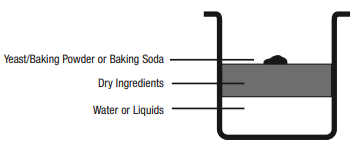
TIPS AND HINTS
Usage
Bread machine baking is affected by the temperature and humidity of the day – this is often the cause of varied dough consistency and results. On a humid day, the best method of measuring is to weigh the flour. A cup of white bread flour weighs 5 ounces/140 grams. A cup of whole wheat flour weighs 4 ounces/120 grams.
Important
If using perishable fresh ingredients such as dairy products, eggs, chopped fruits, or vegetables, do not use the Delay Start Timer feature. Dried ingredients such as dried egg powders, dried buttermilk, or dry milk may be substituted for some dairy products and eggs. Add the water to the machine first, then add the dried substitution after the flour to keep them separate.
Nuts and seeds
Raisins and dried fruits, shredded cheeses, chocolate morsels, and any other additions to the dough should be added when the Mix-in signal sounds for the appropriate programs. For a more uniform loaf of bread, remove the dough when you hear the remove-paddle signal, then remove the kneading paddle and reshape the dough into a neat loaf.
Amounts/Sizes/Ingredients
For white bread and any recipe calling for white flour (unless it is a quick/ batter bread requiring cake flour), the best flour to use is bread flour, which has a higher protein content. A general formula for an 11 ⁄2-pound bread machine loaf is 3 cups bread flour, 11 ⁄8 to 11 ⁄4 cups liquid, 1 teaspoon salt, 1 teaspoon sugar, and 13 ⁄4 to 2 teaspoons yeast. Use this as your basic formula and make adjustments from there.
CLEANING AND CARE
Always turn the bread maker off, remove the plug from the electrical outlet, and allow the unit to cool before cleaning. Never immerse the unit in water or other liquid. To clean the housing and control panel, simply wipe with a clean damp cloth and dry before storing. Never use rough, abrasive materials or cleansers to clean any part of the unit
Lid
If you would like to remove the lid for cleaning, open the lid completely and pull it upward. Never put the lid in the dishwasher. Baking Pan, Kneading Paddle, Measuring Spoon, and Measuring Cup – Wash with warm soapy water and rinse thoroughly, or clean in the upper rack of the dishwasher. Dry all parts after use. If you have trouble removing the kneading paddle from the bread pan, soak it in warm water for 10 to 15 minutes – this will loosen the blade.
TROUBLESHOOTING
The Dough Does Not Rise Properly
Check the expiration date of yeast. Make certain yeast is fresh and properly stored (sealed, in a cool dark place). The liquid may have been too hot and killed the yeast, or the liquid may have been too cool and the yeast did not activate completely – liquids should be between 75° – 90° for best bread machine results. The delay Start feature was used, but the ingredients were in the bread pan in an improper order.
Sunken, uneven tops of loaves
High humidity or high room temperature. Do not place the bread machine in a sunny window. On high-humidity days, try increasing the flour by one tablespoon per cup of flour.
Underbaked, gummy texture
The dough is too wet. When baking the next loaf of the same bread, watch the dough during the first kneading and add additional flour 1 to 2 teaspoons at a time. Too much whole grain or whole grain flour is used. The bread pan is too small for the recipe.
Open texture
The dough is too wet. When baking the next loaf of the same bread, watch the dough during the first kneading and add additional flour 1 to 2 teaspoons at a time.
Dense, heavy texture
The dough is too dry. When baking the next loaf of the same bread, watch the dough during the first kneading and add additional water/liquid 1 teaspoon at a time. This may occur when substituting low-fat products such as fat-free milk or egg replacers, light butter or margarine, fat-free sour cream, or cream cheese. Not enough sugar in the recipe.
Three-Year Limited Warranty
Three-Year Limited Warranty This warranty supersedes all previous warranties on the Cuisinart® Automatic Bread Maker. This warranty is available to consumers only. You are a consumer if you own a Cuisinart® Automatic Bread Maker that was purchased at retail for personal, family, or household use.
California Residents Only
The retail store shall then, according to its preferences, either repair the product, refer the consumer to an independent repair facility, replace the product, or refund the purchase price less the amount directly attributable to the consumer’s prior usage of the product. California residents may also, according to their preference, return nonconforming products directly to Cuisinart for repair or, if necessary, replacement by calling our Consumer Service Center toll-free at 1-800-726-0190.
Before Returning Your Cuisinart Product
If you are experiencing problems with your Cuisinart® product, we suggest that you call our Consumer Service Center at 1-800-726-0190 before returning the product for servicing.
© 2008 Cuisinart Cuisinart® is a registered trademark of Cuisinart 150 Milford Road East Windsor, NJ 08520 Printed in China 08CU178


